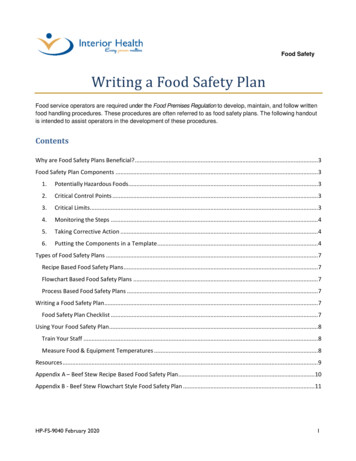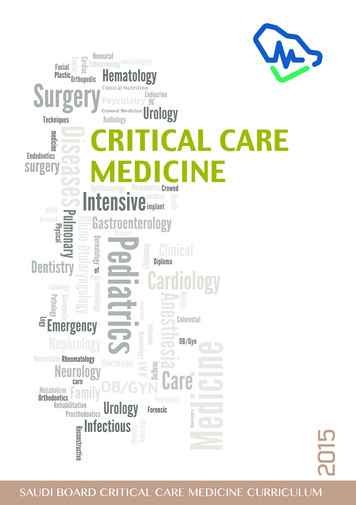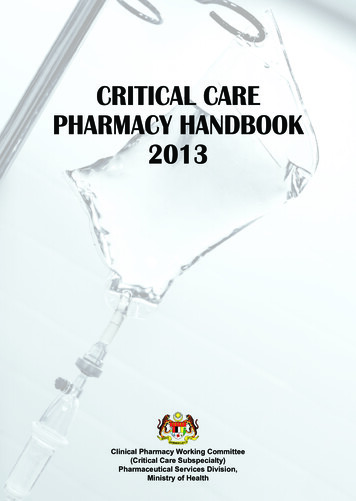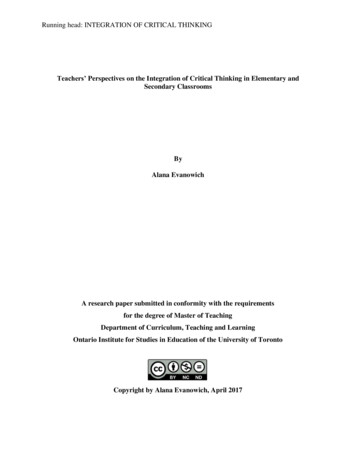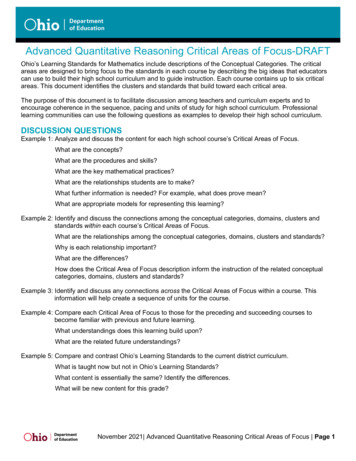
Transcription
Critical Introduction tothe New TestamentM2—Critical Introduction to the New TestamentThis course lays the foundation for in-depth studyof the New Testament by surveying its contents andidentifying pertinent issues in New Testament studies.NationsUniversity 2018nationsu.edu
M2Critical Introduction to the New TestamentThe New Testament in contextThe course lays the foundation for in-depth study of the New Testament by surveying its contents,identifying pertinent issues in New Testament studies, and analyzing the relevance of the New Testamentin a modern world. Emphasis is on original source material. The course is composed of three modules:(1) Biblical Studies, the Gospels and Acts, (2) The Epistles and The Apocalypse, and (3) Message,Response, and Interpretation. Required for the M.T.S. and M.Div. degrees. 3 semester hours of graduatecredit.Objectives Identify characters, issues, events, places, and themes noted in the New Testament Judge underlying assumptions in the critical study of the New Testament Analyze New Testament content for application to contemporary lifeCredit for the course requires a score of 70% or greater on each of 3 multiple-choice examinations andtwo essays. Each element is valued at 20% of the final grade.A sample exam problem is given below:Which of the following has no bearing on the Synoptic Gospels problem? (A) Divergences between theGospels (B) Non-canonical Gospels (C) Similarity of arrangement (D) Similarity of style and wordingResourcesA New Testament in any language is essential. The N.I.V. is recommended as exam problems draw fromits vocabulary. The course syllabus serves as a guide. As a secondary source, the student will find agood introduction beneficial. An online book by Pheme Perkins, Reading the New Testament: AnIntroduction is available at no cost to the student. It may be accessed from the Special ElectronicCollection.Course Learning OutcomesAt the end of the course, the student will be able to1. Relate New Testament characters and sites.2. Analyze the New Testament with a sense of continuity and integration.M 2 Introduction to the New TestamentPage 1
3. Demonstrate through an essay a critical analysis of how the New Testament may function in today’sworld.ExpectationsFollowing is what you may expect in terms of academic engagement and preparation.Academic EngagementEngagement with online Internet articles (7 hours)Viewing videos from Video Library and syllabus link (5 hours)Individualized interaction with student advisor and academic personnel (2 hours)Examinations (3) (3 hours)Using the course syllabus as a guide to reading and study (20 hours)Discussion forum (4 hours)Note taking (2 hours)Proctored comprehensive exam (2 hours)Sub-total—45 hoursPreparationReading the New Testament 3 times (24 hours)Reading Perkins or substitute (336 pages) (13 hours)Preparing for exams (6 hours)Research and writing two essays (40 hours)Reflection activity (7 hours)Sub-total—90 hoursGrand total—135 hoursA Letter from Your ProfessorDear Student,You have embarked on a course that that will introduce you to the content of the New Testament.Furthermore, it will expose you to some of the issues that are raised in a scholarly pursuit of the NewTestament. Although we shall examine books by groups, the result should be a unified understanding ofthe whole corpus.The New Testament stands as a single collection of sacred writings. Yet, it rests upon the foundation ofanother sacred collection—the Old Testament. You supposedly have completed M 1 Critical Introductionto the Old Testament. This course will build upon that study. If you took the undergraduate counter-part,you should be in an improved position to take this graduate level introduction. But if not, do not worry. Wewill walk you through in an orderly manner. It may take more time to assimilate the material, but you willnot miss anything.The Bible—especially the New Testament—is the written foundation for the Christian faith. Were it not forthe New Testament, we would know nothing of Jesus. We would not know how God’s promises made toAbraham and Israel were fulfilled. The New Testament is critical to our faith. It deserves serious attention.I urge you to be open-minded and to pursue truth, wherever it is found. Weigh the content of scripture inthe light of the past and in the light of its consequences. Ask yourself repeatedly what the alternatives areM 2 Introduction to the New TestamentPage 2
for non-belief. Ask also of the benefits of belief. Let this be an adventure. I trust your faith will grow as aresult.Your advisor is available for first line questions. When you need my assistance, the advisor can supplymy e-mail address.Your professorProcedure1. The syllabus has three modules. Review each module to see the layout of the course.2. All the resources you need are online and are available without charge. The book by Perkins shouldbe read along with the syllabus. It can be accessed from the Course Menu under the tab SpecialElectronic Collection. If you prefer to purchase a hard copy text, or desire more reading material, theExpended Resources contains some recommendations.3. Begin your work with Module 1. Read the syllabus carefully. As you proceed, more detailed proceduralinstructions will be given.4. Throughout the course, you are invited to participate in the Discussion Forum.5. As you come to the end of Module 1, you should review the material in preparation for a multiplechoice examination.6. When you are ready for the exam over Module 1, you may open it from the Course Menu. Althoughyou are allowed three attempts, please do not open the exam until you are best prepared as any grade of70 or above will be permanently recorded as your grade for the exam. Exam problems and answers arescrambled on each attempt.7. Once you have completed the exam over Module 1 with a score of 70% or above, move on to the othermodules and repeat the process.8. After you complete Module 3 exam, this would be a good time to watch the videos in the Video Library,found on the Course Menu. The videos are intended to frame your knowledge of the New Testament andpoint in the direction of further considerations and application.9. Construct the two formal essays. Instructions may be found at the end of the syllabus and submittedfrom the Course Menu under Module 3. Each essay is valued at 20 percent of the final grade.10. Following submission of the essays, complete the Course Evaluation, which may be found on theCourse Menu under the Course Summary.11. One more thing. Before proceeding to the next course, you should take a proctored comprehensiveexam. The exam is the first of two qualifying exams required for formal admission into the M.T.S. andM.Div. programs. You may find instructions at the bottom of the Course Menu.M 2 Introduction to the New TestamentPage 3
Things to KnowMODULE 1Personalities1. You should know the identity of the following Old Testament personalities who are noted in theGospels: Abraham, David, Elijah, Isaiah, Jonah, and Moses. These are people who had a significantplace in the story of the Gospels. You will find them referenced in the Gospel narratives.2. Be acquainted with these personalities who appear in the story of the Gospels: Andrew, Anna andSimeon (associated with Jesus' birth), Annas, Barabbas, Bartholomew, Bartimaeus, Beelzebub, CaesarAugustus, Caiaphas, Elizabeth, Gabriel, the various kings named Herod, James and John the sons ofZebedee, Jesus, John the Baptist, Joseph the husband of Mary, Joseph of Arimathea, Judas Iscariot,Judas the son of James/Thaddaeus, James the son of Alphaeus, Jarius, Lazarus, the Magi, Mary ofMagdala/Mary Magdalene, Martha and Mary (the sisters of Lazarus), Mary the mother of Jesus,Matthew/Levi, Nathanael, Nicodemus, Philip, Pilate, Simon of Cyrene, Simon Peter, Simon the Zealot,Theophilus, Thomas, Zacchaeus, and Zechariah.3. Know the identity of demons, Pharisees, Sadducees, and scribes, as these play an important role inthe Gospels.4. You should know the identity of the following personalities who appear in Acts of Apostles: Ananias (ofDamascus), Ananias and Sapphira, the apostles including Matthias, Aquila and Priscilla, Aristarchus,Artemis, Barnabas, Caesar, Candace, Cornelius, Demetrius, Dorcas/Tabitha, Felix, Festus, Gaius, JohnMark, King Agrippa and Bernice, James the brother of Jesus, Lydia, Philip (the evangelist), Saul/Paul,Silas, Simon (the sorcerer), Stephen, Theophilus, and Timothy.Geographical sites1. You should be able to associate some event or person attached to these major geographical sites thatappear in the Gospels: Bethany, Bethlehem, Bethsaida, Caesarea Philippi, Cana, Capernaum, Decapolis,Egypt, the region of the Gadarenes, Galilee, Gethsemane, Jericho, Jerusalem, Jordan River, Judea,Magdala, Nain, Nazareth, Ramah, Samaria, Sea of Galilee, Sidon, Sodom, Tyre, and Zion.2. You should be able to associate some event or person attached to these major geographical sites inActs: Antioch, Asia (Minor), Athens, Berea, Caesarea, Cilicia, Corinth, Crete, Cyprus, Damascus, Derbe,Ephesus, Gaza, Iconium, Jerusalem, Joppa, Judea, Lystra, Macedonia, Malta, Meletus, Philippi, Rome,Samaria, Syria, Tarsus, Thessalonica, and Troas.Content1. You should have a general acquaintance with the events and content of the first four books of the NewTestament. Especially noteworthy are the birth narratives, Jesus' visit to Jerusalem at age 12, John theBaptist's inquiry of Jesus from prison, the apostles' reaction to Jesus' predictions of his impending death,and reactions to various healings like the man born blind.2. Know the events associated with the synagogues at Capernaum and Nazareth and the Sanhedrin andtemple at Jerusalem.3. Know the events surrounding the Passover and the Sabbath.4. Have a general acquaintance with the parables of Jesus, as they provide insight into the nature of thekingdom of God.M 2 Introduction to the New TestamentPage 4
5. Become acquainted with the miracles of Jesus.6. You should have a general acquaintance with the events and content of Acts of ApostlesMODULE 21. Know the identity of the following personalities: Antipas, Diotrephes, Euodia, Gaius, Onesimus,Philemon, Syntyche, Timothy, and Titus.2. You should be able to associate these major geographical sites with appropriate epistles: Colosse,Corinth, Crete, Macedonia, Philippi, Rome, Thessalonica, Patmos and the seven churches of Asia-Ephesus, Laodicea, Pergamum, Philadelphia, Sardis, Smyrna, and Thyatira.3. Know the authors of each New Testament book where an author is associated with the text.4. Know also the persons or churches to whom each epistle was addressed.5. Be able to identify each epistle by major distinguishing features and content.MODULE 31. You should have a general acquaintance with the role of Jesus Christ in providing redemption tohumanity. Concentrate especially on the theological ideas related to sin, redemption, law and grace, andthe person and work of Jesus.2. You should have a general understanding of the expectant behavior of the Christian.3. At the conclusion of the third module, you should comprehend the New Testament sufficiently todetermine its universal application.Special Electronic CollectionThe student is expected to read the following book as he/she follows the syllabus. Chapters 1-7 shouldbe read in conjunction with Module 1. Chapters 8-21 should be read in association with Module 2.Perkins, Pleme. Reading the New Testament: An Introduction. 3rd ed. Paulist Press, 2012.Extended ResourcesThe following books are recommended for further reading. Extended Internet sources related to thecontent of the course are found within the syllabus.Blomberg, Craig L. The Historical Reliability of the Gospels. IVP Academic, 2007. 416 pages. 15.47ISBN: 978-0830828074. The Historical Reliability of the New Testament. B&H Academic, 2016 816 pages. 25.39ISBN: 978-0805464375Boring, M. Eugene. An Introduction to the New Testament: History, Literary, Theology. WestminsterJohn Knox Press, 2012. 33.75 ISBN: 978-0664255923M 2 Introduction to the New TestamentPage 5
*Carson, D. A., Douglas J. Moo, and Leon Morris. An Introduction to the New Testament. 2nd ed.Zondervan, 2005. 784 pages. 26.99 ISBN: 978-0310238591*deSilva, David A. An Introduction to the New Testament: Contexts, Methods & Ministry Formation.IVP Academics, 2004. 975 pages. 33.27 ISBN: 978-0830827466Kostenberger, Andreas J.; L. Scott Kellum; Charles Quarles. The Cradle, the Cross, and the Crown:An Introduction to the New Testament. B & H Academic, 2009. 976 pages. 39.31 ISBN: 9780805443653Patzia, Arthur G. and Anthony J. Petrotta. Pocket Dictionary of Biblical Studies. IVP Academic, 2002.128 pages. 8.99 ISBN: 978-0830814671Powell, Mark Allan. Introducing the New Testament: A Historical, Literary, and TheologicalSurvey. Baker Academic, 2009. 560 pages. 23.68 ISBN: 978-0801028687*Highly recommendedSelect LibraryThe following sources contain valuable online collections of articles and books that can prove helpful instudying special topics related to an introduction to the New Testament.The Bible in multiple translations, GatewayActs of the Apostles, BiblicalStudies.org.ukBiblica, Internet Archive Wayback MachineCriticism, BiblicalStudies.org.ukDiscourse Criticism, BiblicalStudies.org.ukThe Gospels, BiblicalStudies.org.uk"The Challenge of Canonical Criticism to Background Studies" by Randy W. Nelson, Journal ofBiblical Studies 6, 2 (June 2006): 10-34Journal of Biblical StudiesNew Testament, BiblicalStudies.org.ukNew Testament, religion-online.orgNew Testament Introduction, Open LibraryNew Testament Introduction, Universal LibraryNew Testament Introduction and Commentary, Eastern UniversityNew Testament Letters, BiblicalStudies.org.ukMethodology, Internet Archive Wayback MachineRevelation, BiblicalStudies.orgM 2 Introduction to the New TestamentPage 6
MODULE1Biblical Scripture, the Gospels, and ActsThe Christian Bible consists of two parts: (1) writings composed primarily in the Hebrew language, with afew sections in the wider Aramaic tongue and (2) writings composed in Koiné Greek, the commonlanguage of the Hellenistic world. The Greek Scriptures (commonly known among Christians as the NewTestament) comprise part of the canon of writings, which Christians generally hold to be sacred and“inspired” by God. All of the writings belong to the 1st century C.E. and were composed by apostles (i.e.,men who were specially appointed by Jesus), or by men closely associated with the apostles.Christians consider the Greek Scriptures a “continuation” of the Hebrew Scriptures, but with an importantdifference—a particular covenant that the different sets of scripture represents. The Jews hold to thecovenant Yahweh formed with their ancestors through Moses at Sinai. Christians live under a newcovenant that God established in Jesus Christ. Since Jews do not recognize the “New” Testament asscripture, they generally refer to the “Old” Testament as the Tanakh, the Holy Scriptures, or the HebrewScriptures.The Hebrew Scriptures (referred to by Christians as the “Old” Testament) designate writings that belongto a period prior to the birth of Jesus. With the exception of the books of Genesis and Job, these writingspertain to people living under the Sinai covenant. For subscribers to the Jewish faith, the HebrewScriptures are complete as “written” scripture. Jews may also recognize an authoritative “oral” traditionalongside the written scriptures, but they definitely do not recognize the Greek Scriptures as carrying anyauthority for their faith. For Christians, on the other hand, the story of the Bible as written scripture isincomplete without the New Testament.If one wonders why we sometimes refer to the New Testament as “The Greek Scriptures,” there areseveral reasons. One, we want to identify the collection in a manner that is both descriptive and reflectiveof the Christian tradition. Two, we wish to present the Old Testament in a positive light. It must not berelegated to an irrelevant past, but positioned for the proper Christian use. There exists an essential linkbetween the two testaments, as New Testament writers used the Old Testament to unfold the New.Therefore, the link is essential to the climax to which the New Testament leads. Perceiving how this isdone, how prophecy is interpreted, and the full implication of an Old Testament citing create a foundationfor valid interpretation.In the Greek Scriptures, we are reintroduced to names and events given in detail in the HebrewScriptures—and for good reason. In the Greek Scriptures we find God's promises to Israel were fulfilled inJesus Christ. Here one learns how God interceded into human history and provided a universal means ofhuman redemption. The New Testament reveals the means to righteousness , a spiritual relationship withGod, and a realistic hope amid the struggles of this life.As in our study of M 1, we shall concentrate on people, places, and events. This may seem to be thelower level of modern learning categories, but it is necessary. What raises the level of learning is that in M1 and M 2, you are learning how to work with original sources. In later courses, we will ask deepertheological questions and we will provide opportunity for additional analysis. For now, it is essential thatwe concentrate on the “fact.” Without this phase, you will be hopelessly lost in your quest to know andmake use of the Bible.Module 1 sets the stage by looking at the nature of biblical scripture and the content of the first five booksof the New Testament. The Gospels and Acts span two-thirds of the 1st century. The Gospels cover thefirst third and Acts the second third. Many of the Epistles fit into the time period covered by Acts, makingActs the basic historical setting for all the New Testament. In this module, we shall examine the fivedocuments with a view toward understanding core elements: characteristics, themes, literary structure,historical context, and contents.M 2 Introduction to the New TestamentPage 7
The central figure in the Gospels and Acts is Jesus Christ. The validity of the entire gospel rests upon anaccurate portrayal of the person and teachings of Jesus. The Gospels and Acts declare Jesus' divinity,messiahship, and resurrection as essential elements in human redemption from sin and reconciliationwith God. One need not adopt the stance that Jesus was a product of his time to explain his person or histeachings. Yet, Jesus became a man in time. He, therefore, addressed people whose ideals, aspirations,and predispositions were forged on the anvil of accepted traditions.The institutions mentioned in the Gospels and Acts--synagogue, temple, Sanhedrin--had a history. Theywere also living organisms, maintained by priests, scholars, scribes, and elders. Then, there was thepolitical structure--both Jewish and Roman--floating in a sea mixed with both Hebraic and Hellenisticculture. Gymnasium, stadium, and theater were characteristic of Hellenistic--not Jewish--culture. TheJewish religious and governing system was divided between two parties--the Pharisees and Sadducees-Jewish sects with diverse theologies and functions.Preparing for Module 1 Exam1. Review the text of the syllabus under Module 1.2. Read the first four books of the New Testament--Matthew, Mark, Luke, and John--to become familiarwith the material.3. Read the Gospels again. This time, make notes on the major participants, institutions, place names,events, and teachings.4. Read the four books again and again, stopping only when you need to make sure you have the contentfirmly in mind.5. Continue to research the names, places, teachings, and events noted in this module.6. Familiarize yourself with the critical issues noted in the syllabus and with the assumptions that underlieproposed solutions.7. When you feel competent with the Gospels, move on to Acts. Read Acts to become familiar with thematerial--people, places, events, and message.8. Read Acts again and again until the book becomes thoroughly familiar. As you read, look for examplesof different literary genre, such as story, speech, and quotation. Let your knowledge of the setting andliterary characteristics of the book help you interpret and understand its content.The exam will present problems covering the items noted in the Things to Know block. You will not beexpected to know which Gospels contain specific details about the same event or which Gospel containsa unique rendering. Rather, you should concentrate on learning the stories, dialogues, parables, andmiracles by viewing the Gospels as a complete presentation of Jesus Christ.Unit 1. Biblical ScriptureThe "Greek Scriptures" are one and the same as the New Testament. The corpus is called the "Greek"Scriptures because the writings were composed in the Greek language. The idea of a "New" Testamentdistinguishes the collection from the "Old" Testament.With the Jews, Christians acknowledged the authenticity and authority of the Hebrew Scriptures (OldM 2 Introduction to the New TestamentPage 8
Testament). In addition to the Hebrew Scriptures, Christians recognized twenty-seven additionaldocuments or "books" as authentically representing the mind of God. These works received the title"New" Testament (Covenant), because they described the new covenant God was inaugurating as thefulfillment of the Law of Moses and the Prophets of Israel. Hence, the "New" Testament made the formerone the "Old" Testament. This new covenant, intended for Gentiles as well as for Jews, centered onJesus.The central message of the New Testament and of apostolic proclamation is anchored in both theteaching and the person of Jesus Christ. Jesus announced the good news about the kingdom of God,which he himself was now bringing to men. But Jesus was more than a teacher and prophet. He was alsothe long-awaited Messiah promised to Israel. He was both the bearer of the message of salvation and itsessential content. The Gospels focus on Jesus, who simultaneously revealed the mind of God andbecame the instrument of human redemption. Acts of Apostles describes the spread of the good news.The Epistles elaborate on meaning and application. The Apocalypse declares Christ's victory over Satan.The story of the Bible is that of immortal God and his creation. He made man in his own image. Beingholy and righteous man lived in a wholesome relationship with God. Man, however, desiring to be more,sinned and ended the paradisaical relationship. All was not lost to man, though. God, moved by mercy,love, and a desire for his perfect glory, set out to bring redemption to mankind. Through the ages, herevealed himself and created a covenant with descendants of Abraham. Through these people, Godwould introduce his Son to the world. By glorifying the Father through his sacrificial love, Jesusreestablishes the redeemed man in keeping with the perfection that is the glory of God. This is the "goodnews" or "gospel" that the New Testament announces.The gospel is concerned foremost with the glory of God. Achieving the glory of God is not about satisfyinga self-centered despot, but the realization of the intention of God for man. Since man is of divine design,he fulfills his purpose when he lives in holiness and righteousness. The failure of man to do this leaveshim helpless and groping in darkness. Only God can furnish the light of redemption and act in behalf ofman's redemption.The gospel contains both ethical and factual teaching related to Jesus Christ. It is the good news aboutGod's effectual grace to humanity. The gospel embraces the "mystery" of God. This long-concealedmystery was purposed before the foundation of the world, promised through Abraham, foreshadowed bythe Law of Moses, foretold by the prophets of Israel, prepared for by John the baptizer, fulfilled by Jesusthe Christ, and revealed through Jesus' apostles.The New Testament offers exciting reading as a dynamic composition. But when considered against its1st century environment, it takes on a real life atmosphere. Just sensing the emotions, uncertainties, andgeneral expectations brings it close to the reader. Stepping back into the 1st century environment givesan even greater ring of authenticity. To sit on the mountain slopes overlooking the Sea of Galilee, to walkthe streets of Jerusalem, to gaze upon the landscape of Ephesus, to sit on Mars Hill in Athens, or to standwithin the Roman Forum brings a feeling of awe. But as exciting as that may be, a 21st century presencecannot reproduce the full impact of the scenes described in the Bible two millennia ago. Since the NewTestament reports actual events, as much of that real environment as is possible needs to bereconstructed in order to receive maximum benefit from reading the New Testament.Hundreds of years have passed since the books of scripture were penned. Many would-be interpretershave arisen. Varying assumptions have been advanced regarding composition and background. As thestudy of the Bible becomes more personal for you, it will be important to review the evidence on whichscholars and commentators reach their conclusions.Each book of the New Testament was composed for a given purpose and a particular audience. Sincethe human writers belonged to the 1st century C.E., they wrote in a social, political, and religiousenvironment. This is not to say that the authors merely mirrored their environment or accepted culturalperceptions. They often wrote against prevailing customs and practices. But they did use standardM 2 Introduction to the New TestamentPage 9
conventions of language, literary forms, and vocabulary. They referenced events and ideas that were partof their culture.The study of Jesus and the Gospels presents some interesting situations. For example, the birthnarratives note that Jesus' birth coincided with a Roman-ordered census. King Herod attempted to killJesus. Traditional Jewish ideas and attitudes impacted how Jesus' message was received. Jewishinstitutions that had emerged during the Intertestamental Period were firmly in place. And Romansovereignty influenced the outcome of Jesus' trial and crucifixion.Two principles guide us in our approach to the New Testament. One, we assume the truthfulness anduniqueness of the biblical witness. Two, we will treat the biblical text as a document produced within areal historical environment. The Bible is taken at face value. It is not about perfect people, but about howGod works in, among, and through imperfect people for his own purposes.This unit looks at issues that pertain to the formation of the New Testament text, as well as compositionand relevant background situations. First, we shall review the New Testament corpus in general and thefour Gospels and Acts in particular. Second, we will consider approaches and methods to the study of theGospels. Third, we shall entertain the subject of New Testament backgrounds.a. The corpus, the four Gospels, and Acts of Apostles. What makes the New Testament special? Isits content unduplicated elsewhere in non-biblical literature? How did the books of the Bible cometogether to form "scripture"? We shall begin with the last question, which introduces the study of thebiblical "canon" or list of scriptural books.The corpus. When referring to the group of books that belong to the Bible, we often speak of the "canon."The term comes from a Greek word (kanon), which indicated a rod for measuring. Hence, when applied tothe discussion of which books belong to the Bible, the word canon came to signify a rule for measuringthe legitimacy of books that determine Christian faith and life. Then, the idea of a canon becamesynonymous with the list itself. Study of the canon is not an inquiry into why certain books should beincluded in the Bible, but recognition of the books that were generally accepted by the users. At stake iswhether the New Testament is authentic, reliable, and authoritative. This is important because theprimary sources of information concerning Jesus are the Four Gospels.The idea of an official "canon" or "corpus" of scripture does not appear to have existed at the time ofJesus. However, those books which would have been recognized by the Jews would have embraced thebooks included in the Protestant Old Testament. By default, then, a canon or idea of authoritativescriptures did exist, although technically, the Jews appear to have settled the matter of the HebrewScriptures in 90 C.E. When New Testament personalities spoke of "the Scriptures" they were referring tothe thirty-nine books of the "Old Testament" that appear in the Protestant Bible. Hence, Jewish andGentile Christians recognized the Jewish canon, although they continued to review the list and expand itto include the New Testament. However, the Roman Catholic Church extended the debate over the OldTestament canon for hundreds of years and still accepts as canonical some Intertestamental works thatneither Jews nor Protestants recognize. The complete canon of scripture for Christians also includescompositions by the apostles, who wrote under inspiration of the Holy Spirit.As for the New Testament, the matter of a specified list of books considered as scripture was settledduring the 4th century. Earlier, the Epistle of Clement of Rome to the Corinthians in 95 C.E. offersevidence that the writer was familiar with a number of the Pauline epistles, suggesting that perhaps all ofthe apostle Paul's letters had been collected into a single group before the end of the 1st century.Although multiple "Gospels" were produced, only four received wide acceptance as faithfulrepresentations.Lists of canonical books were circulated fairly widely during the 2nd century. For those representingmainstream Christianity, the lists were very similar, with only a few titles being disputed. However, the riseof heretical teachings and advocates provoked discussion as to which compositions should be regardedM 2 Introduction
The Bible—especially the New Testament—is the written foundation for the Christian faith. Were it not for the New Testament, we would know nothing of Jesus. We would not know how God’s promises made to Abraham and Israel were fulfilled. The New Testament



